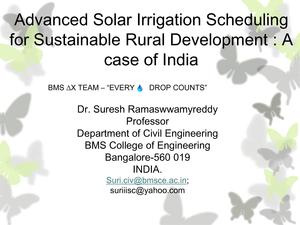Advanced Solar Irrigation Scheduling for Sustainable Rural Development: A Case of India
From energypedia
The printable version is no longer supported and may have rendering errors. Please update your browser bookmarks and please use the default browser print function instead.
Advanced Solar Irrigation Scheduling for Sustainable Rural Development: A Case of India
Presenter: Hari D. K. (FluxGen Engineering Technologies Pvt. Ltd., India) and Suresh K.R (BMS College of Engineering, India)
Rapporteur: Max Morrison
Overview
| In the past few years, there have been large migrations from the rural to the urban areas of India as the country has developed. This has led to shortage of agricultural manpower in rural India, a region which is essential for the country’s food security. Also, groundwater depletion in rural areas is affecting agriculture. Automating some agricultural tasks in a sustainable, scientific way could address this, leading to decreased water and energy use and increased crop yields. We develop a research platform to implement proof-of-concept of a system for precision agriculture incorporating renewable energy sources and information technology. Data collected by this system will be used to design a low-cost, commercial version of this technology for the rural Indian farmer.[1] |  |
Issues Presented
► Please see the presentation.
- Intermittent of rain is a huge source of stress for rain dependent farmers.
- The recharge area of aquifers are being blocked, more wells being drilled.
- Thus furrow irrigation is much more common and easy. Trickle/Drip irrigation is much more efficient.
- Low education level leads to over-watering and less than ideal crop yields.
- High effort, high cost irrigation methods decrease possible yield for investors.
- Different growth stages have different water requirements, and different sensitivities to these requirements being met.
- Sensors at .25, .5, .75, 1 meter depth. Monitors moisture looking for lower threshold of plant root absorption.
- Sensors send data to Electricity Control Panel, requests certain amount of water, solar pump delivers the correct amount of water.
- GUI allows selection of soil type, crop type, sowing data, etc.
Q & A
1. How do you expect to take this to the farmers?
- Farmers will not come to the college. We want to implement these at centers that farmers gather at. They will prove themselves and hopefully the farmers will observe this and be convinced of their efficacy.
2. How will this scale up?
- The actual unit will probably have 1-2 sensors rather than 4 to decrease the cost.
3. Some farmers may think that this development is frightening. Will farmers have more confidence in a local NGO?
Further Information
References
- ↑ Advanced Solar Irrigation Scheduling for Sustainable Rural Development: A Case of India. Hari D. K. H. Mitavachan. Suresh K. R. and Ganesh Shankar.




















